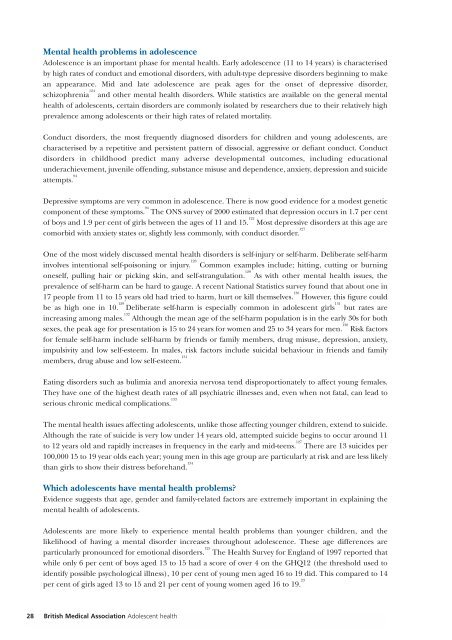Alcohol misuse: tackling the UK epidemic - London
Alcohol misuse: tackling the UK epidemic - London
Alcohol misuse: tackling the UK epidemic - London
Create successful ePaper yourself
Turn your PDF publications into a flip-book with our unique Google optimized e-Paper software.
28<br />
Mental health problems in adolescence<br />
Adolescence is an important phase for mental health. Early adolescence (11 to 14 years) is characterised<br />
by high rates of conduct and emotional disorders, with adult-type depressive disorders beginning to make<br />
an appearance. Mid and late adolescence are peak ages for <strong>the</strong> onset of depressive disorder,<br />
schizophrenia 124<br />
and o<strong>the</strong>r mental health disorders. While statistics are available on <strong>the</strong> general mental<br />
health of adolescents, certain disorders are commonly isolated by researchers due to <strong>the</strong>ir relatively high<br />
prevalence among adolescents or <strong>the</strong>ir high rates of related mortality.<br />
Conduct disorders, <strong>the</strong> most frequently diagnosed disorders for children and young adolescents, are<br />
characterised by a repetitive and persistent pattern of dissocial, aggressive or defiant conduct. Conduct<br />
disorders in childhood predict many adverse developmental outcomes, including educational<br />
underachievement, juvenile offending, substance <strong>misuse</strong> and dependence, anxiety, depression and suicide<br />
attempts. 94<br />
Depressive symptoms are very common in adolescence. There is now good evidence for a modest genetic<br />
component of <strong>the</strong>se symptoms. 94<br />
The ONS survey of 2000 estimated that depression occurs in 1.7 per cent<br />
of boys and 1.9 per cent of girls between <strong>the</strong> ages of 11 and 15. 122<br />
Most depressive disorders at this age are<br />
comorbid with anxiety states or, slightly less commonly, with conduct disorder. 127<br />
One of <strong>the</strong> most widely discussed mental health disorders is self-injury or self-harm. Deliberate self-harm<br />
involves intentional self-poisoning or injury. 128<br />
Common examples include; hitting, cutting or burning<br />
oneself, pulling hair or picking skin, and self-strangulation. 129<br />
As with o<strong>the</strong>r mental health issues, <strong>the</strong><br />
prevalence of self-harm can be hard to gauge. A recent National Statistics survey found that about one in<br />
17 people from 11 to 15 years old had tried to harm, hurt or kill <strong>the</strong>mselves. 130<br />
However, this figure could<br />
be as high one in 10. 129<br />
Deliberate self-harm is especially common in adolescent girls 131<br />
but rates are<br />
increasing among males. 132<br />
Although <strong>the</strong> mean age of <strong>the</strong> self-harm population is in <strong>the</strong> early 30s for both<br />
sexes, <strong>the</strong> peak age for presentation is 15 to 24 years for women and 25 to 34 years for men. 130<br />
Risk factors<br />
for female self-harm include self-harm by friends or family members, drug <strong>misuse</strong>, depression, anxiety,<br />
impulsivity and low self-esteem. In males, risk factors include suicidal behaviour in friends and family<br />
members, drug abuse and low self-esteem. 131<br />
Eating disorders such as bulimia and anorexia nervosa tend disproportionately to affect young females.<br />
They have one of <strong>the</strong> highest death rates of all psychiatric illnesses and, even when not fatal, can lead to<br />
serious chronic medical complications. 133<br />
The mental health issues affecting adolescents, unlike those affecting younger children, extend to suicide.<br />
Although <strong>the</strong> rate of suicide is very low under 14 years old, attempted suicide begins to occur around 11<br />
to 12 years old and rapidly increases in frequency in <strong>the</strong> early and mid-teens. 127<br />
There are 13 suicides per<br />
100,000 15 to 19 year olds each year; young men in this age group are particularly at risk and are less likely<br />
than girls to show <strong>the</strong>ir distress beforehand. 134<br />
Which adolescents have mental health problems?<br />
Evidence suggests that age, gender and family-related factors are extremely important in explaining <strong>the</strong><br />
mental health of adolescents.<br />
Adolescents are more likely to experience mental health problems than younger children, and <strong>the</strong><br />
likelihood of having a mental disorder increases throughout adolescence. These age differences are<br />
particularly pronounced for emotional disorders. 125<br />
The Health Survey for England of 1997 reported that<br />
while only 6 per cent of boys aged 13 to 15 had a score of over 4 on <strong>the</strong> GHQ12 (<strong>the</strong> threshold used to<br />
identify possible psychological illness), 10 per cent of young men aged 16 to 19 did. This compared to 14<br />
per cent of girls aged 13 to 15 and 21 per cent of young women aged 16 to 19. 23<br />
British Medical Association Adolescent health
















